- Andere Unternehmen von Fluke:
- Fluke
- Fluke Biomedical
- Fluke Networks
- Fluke Process Instruments
Selecting a dry-block calibrator
Dry-block calibrators are stable temperature sources for calibrating sensors such as dial thermometers, resistance temperature detectors (RTDs) and thermocouples.These sensors are used for process manufacturing in many industries.They need to be checked or calibrated periodically. Watch the How to Calibrate a Digital Thermometer with a Dry Block video for an example.
Since dry blocks are portable, fast, and clean (do not use fluids), they are popular for on-site sensor calibration in process manufacturing. If you are considering a purchase of a dry block, you should first answer three questions:
1. What type and size are the temperature sensors that need to be calibrated?
2. What temperature range is needed for sensor calibration?
3. What calibration accuracy is required?
1. What type and size are the temperature sensors that need to be calibrated?
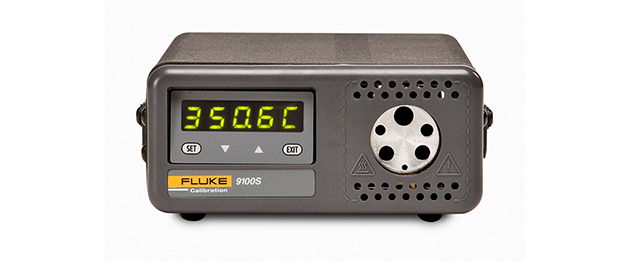
As the name implies, a dry-block calibrator has a metallic block that is heated or cooled and often includes an insert with pre-drilled holes of various diameters. During calibration, the sensor being calibrated (called a device under test or DUT) is fully inserted into one of the pre-drilled holes. Dry blocks work great for sensors such as dial thermometers, many RTDs, and thermocouples that are long, straight, and have a diameter that fits snuggly in the insert hole.
Some RTDs are short, have tri-clamp (tri-clover) fittings, or transmitter heads attached. These short and odd-sized sensors can’t fit with proper immersion depth into dry blocks. These types of sensors are best calibrated using 6109A/7109A Portable Calibration Baths or 6102/7102/7103 Micro-Baths.
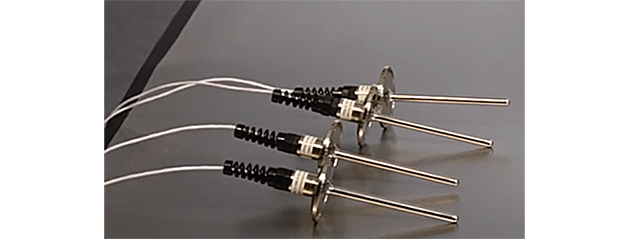
2. What temperature range is needed for sensor calibration?
Common process manufacturing applications cover a variety of temperature ranges. Here are some examples of temperature ranges for common process manufacturing applications:
- Freezers: –95 to –60 ºC
- Freeze drying: –80 to –50 ºC
- Blood banks: –50 to –30 ºC
- Washer disinfectors: up to 70 ºC
- Autoclave sterilization: 120 to 135 ºC
- Steam-in-place (SIP) sterilization: 121 ºC
- Food processing: 0 to 220 ºC
- Process control & automation: up to 1000+ ºC
Each company usually has a policy about which temperature points are required for sensor calibration. If a policy isn’t available, a best-practices recommendation is to calibrate sensors over the entire temperature range they are monitoring. Referred to as bracketing, it is also common practice to select calibration points beyond the DUT’s measurement range by ±10 °C.
3. What calibration accuracy is required?
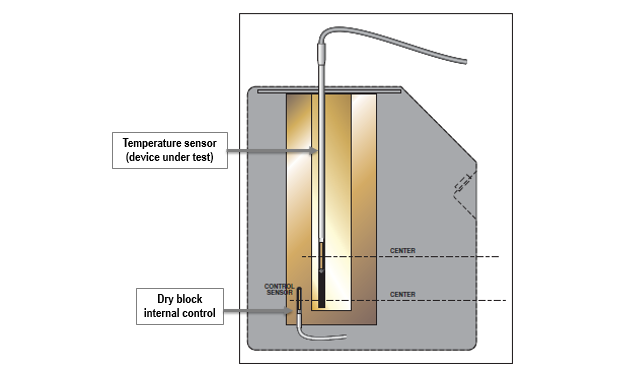
Temperature sensor calibration is done by a comparison test of the sensor with a reference standard like a dry-block calibrator. See the How to Do a Temperature Sensor Comparison Calibration blog article for more on the comparison calibration process.
Generally speaking, the reference standard needs to be at least four times more accurate than the sensor being calibrated (4:1 test uncertainty ratio, or TUR). For example, if the process tolerance for a temperature sensor is ±0.8 ºC, then the dry block being used as the measurement standard must have an accuracy of ±0.2 ºC or better.
Dry blocks use an internal control sensor for their display accuracy specification. There are two options to improve dry-block accuracy by using an external reference PRT (platinum resistance thermometer):
Option 1. Dry block with process controls
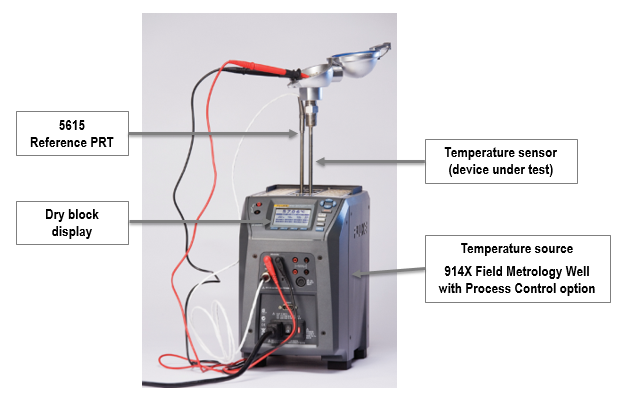
Field metrology well with reference PRT option
Some dry-block models offer a process control option that includes a built-in reference thermometer for measuring an external reference PRT. The external PRT measurement is shown on the dry-block display along with the temperature of the internal control sensor. Since the external reference PRT is more accurate than the dry block’s internal control sensor, the overall measurement accuracy is improved. See the 914X Field Metrology Well example below.
Option 2. Dry block with thermometer readout
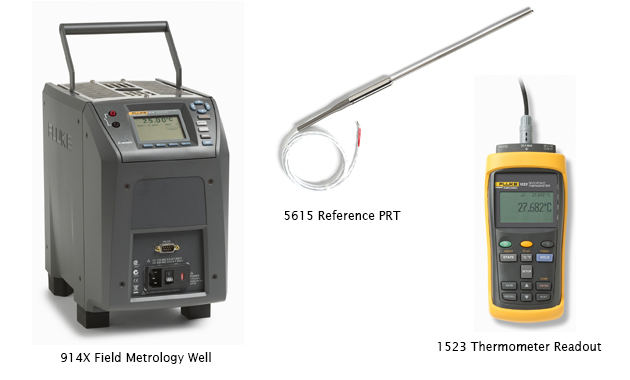
Another alternative is to use an external reference PRT coupled with an external thermometer readout to improve dry-block accuracy. For example, a 5615 Reference PRT is inserted into a 914X Field Metrology Well (no process control option). Next the PRT is connected to the 1523 Thermometer which reads the PRT temperature. The 914X shows the internal control temperature measurement on its display.
The price for both options is about the same. The dry block with process control option is more convenient for field work since it combines the temperature source and thermometer readout into a single unit. But the dry block with external thermometer readout option provides the flexibility of a separate, portable readout for field and lab use. One benefit of this configuration is that the dry block can be used as an uncalibrated temperature source since calibration traceability comes from the external reference thermometer and readout.
Watch the Fluke Dry-block Calibrator Overview Video for a summary of the wide-range of dry blocks we offer for temperature sensor calibration. Please refer to the Fluke Calibration Dry-Block Product Comparison for guidance in choosing the right dry-block based on type of sensors you’re calibrating, temperature range, and accuracy needed. If you need additional help, speak with one of our experts.
Keep learning
Dry-Block Calibrators vs. Temperature Baths: Choosing the Right One for You - app note
Introduction to Dry Block Calibrators - video
Metrology Wells Versus Dry-Wells: Do Vertical Gradients Really Matter? - app note
How to Calibrate an RTD or Platinum Resistance Thermometer (PRT) - app note
Recommended products
Calibration reference probes & sensors
Get help
Need help choosing a product? Speak with a calibration equipment expert
- Anmelden oder Registrieren um Kommentare zu schreiben
- Printer-friendly version »
- Startseite
- Produkte
- Neue Produkte
- Elektrische Kalibrierung
- HF-Kalibrierung
- Datenerfassung und Testgeräte
- Temperaturkalibrierung
- Feuchtekalibrierung
- Druckkalibrierung
- Kolbenmessgeräte
- Controller/Kalibratoren
- Druckmonitore
- Druckwaagen
- Manuelle Kalibratoren und Monitore
- Handheld Pressure Calibrators
- Luftdaten-Kalibrierung
- Messgeräte zur Überwachung der Umgebungsbedingungen
- Druckkalibrierungszubehör
- Benutzerdefinierte Druckkalibriersysteme
- Software zur Druckkalibrierung
- Durchflusskalibrierung
- Prozesskalibratoren
- Kalibriersoftware
- Service und Support
- Alle Kalibriergeräte
- Hand-Messgeräte
- Kaufinfo
- Aktuelles
- Schulung/Veranstaltungen
- Literatur/Ausbildung
- Service/Unterstützung
- Service Request (RMA)
- Serviceprogramme
- Technischer Support
- Wissensbasis
- Akkreditierung
- Autorisierte Servicezentren
- Calibration Certificates
- Community Forum
- My MET/SUPPORT
- Produkthandbücher (Bedienungsanleitungen)
- Sicherheitsdatenblätter (SDS)
- Recyclingprogramm
- Safety, Service, and Product Notices
- Gewährleistungen
- Software-Downloads
- Über uns


